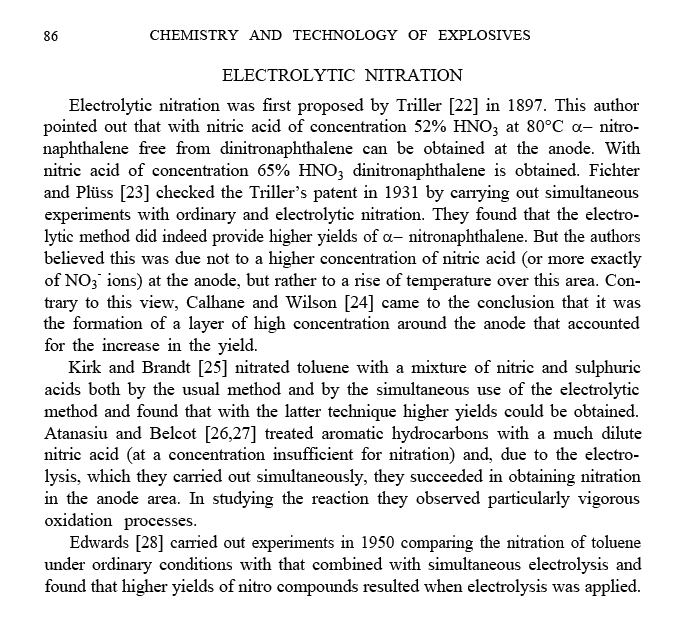
chief - 6-4-2010 at 03:03
In The Urbanski, on page 19, there is mentioned "electrolytic nitration", Atanasiu and Berthelot, 1937/1937 ..
It's done from diluted HNO3, which is concentrated in the anode-space, where the nitration takes place ...
Storng oxydizing processes go on at the same time in this anodic space ...
===============
That sounds very interesting: It might prevent any thermal runaway-danger etc. etc.
Are there any detailed sources about this on the net ?
===============
It might even suffice to have some nitrate-solution , mix into it the stuff to be nitrated ... and electrolyze ...
==> This would work best with an nitro-ester which ppt.s out from aquaeous solutions ... ...
[Edited on 6-4-2010 by chief]
quicksilver - 6-4-2010 at 06:09
I read the same thing some time ago.....I also thought the same about temperature maintainability. I looked, but not finding anything is not too
unique. What I did find is some (somewhat) related patents but nothing with nitration per se'.
Likely we're looking at more than one problem. The problem of the electrodes being ruined is not just a $ issue but may change conditions.
Additionally the construction of the unit would be challenging as even if some nitration were picked that had a wide temp "window" you have the
problem of the additions & fumes. Likely, you would need a vacuum unit & a unique cell construction.
hissingnoise - 6-4-2010 at 07:35
In COPAE, pp 228-229, Davis mentions an electrolytic process to nitrate ethylene using a Pt gauze anode.
franklyn - 6-4-2010 at 12:19
Old bones
http://www.sciencemadness.org/talk/viewthread.php?tid=1716#p...
See the post below that _
http://www.sciencemadness.org/talk/viewthread.php?tid=1716#p...
also from Urbanski v.1 , p. 86

[Edited on 6-4-2010 by franklyn]
12AX7 - 6-4-2010 at 18:18
Weird thing is, electrolysis is a radical process, different from the electrophilic substitution taking place. It doesn't really make sense, so
you're only using secondary effects, like the increased concentration or acidity at the anode.
Tim
